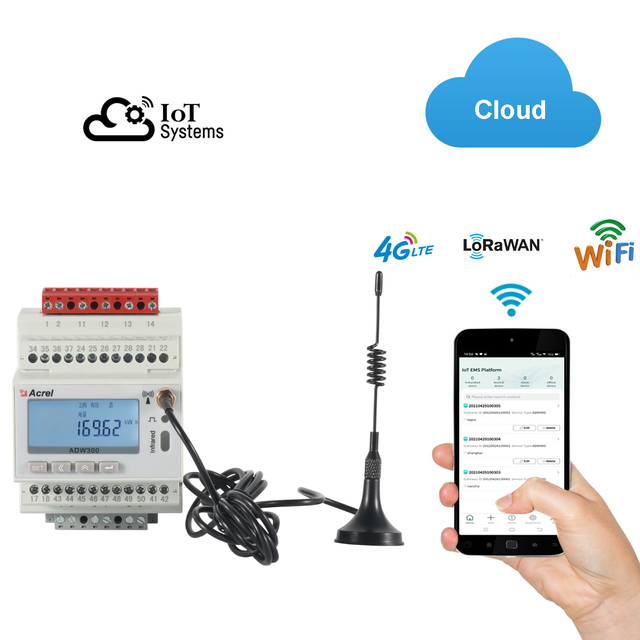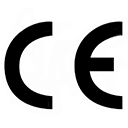Acrel ADW300 IOT Wireless Smart Energy Meter
Measurement: 3-phase Active Power, Reactive Power, Current, Voltage, Harmonic and etc.
Rated Current: 3x1(6)A AC (via CTs)
Rated Voltage: Up to 3x660~792Vac L-L
LCD Display: 8 digits
Communication: RS485,LoRa,4G,NB-IoT or WIFI
HMI Programming: Setting of CT/PT Ratio, Phase Wiring, Communication and etc
Application Scenario: Building, Factory, Smart Grids, DB Room and etc
Standard&Certificate: CE; IEC; LVD
ADW series din rail energy meter is mainly used for metering three phase active energy on low voltage network or medium voltage. There are 4G, WiFi, LoRa and etc communication way in order to help customers check, get and manage the value of energy consumption remotely.
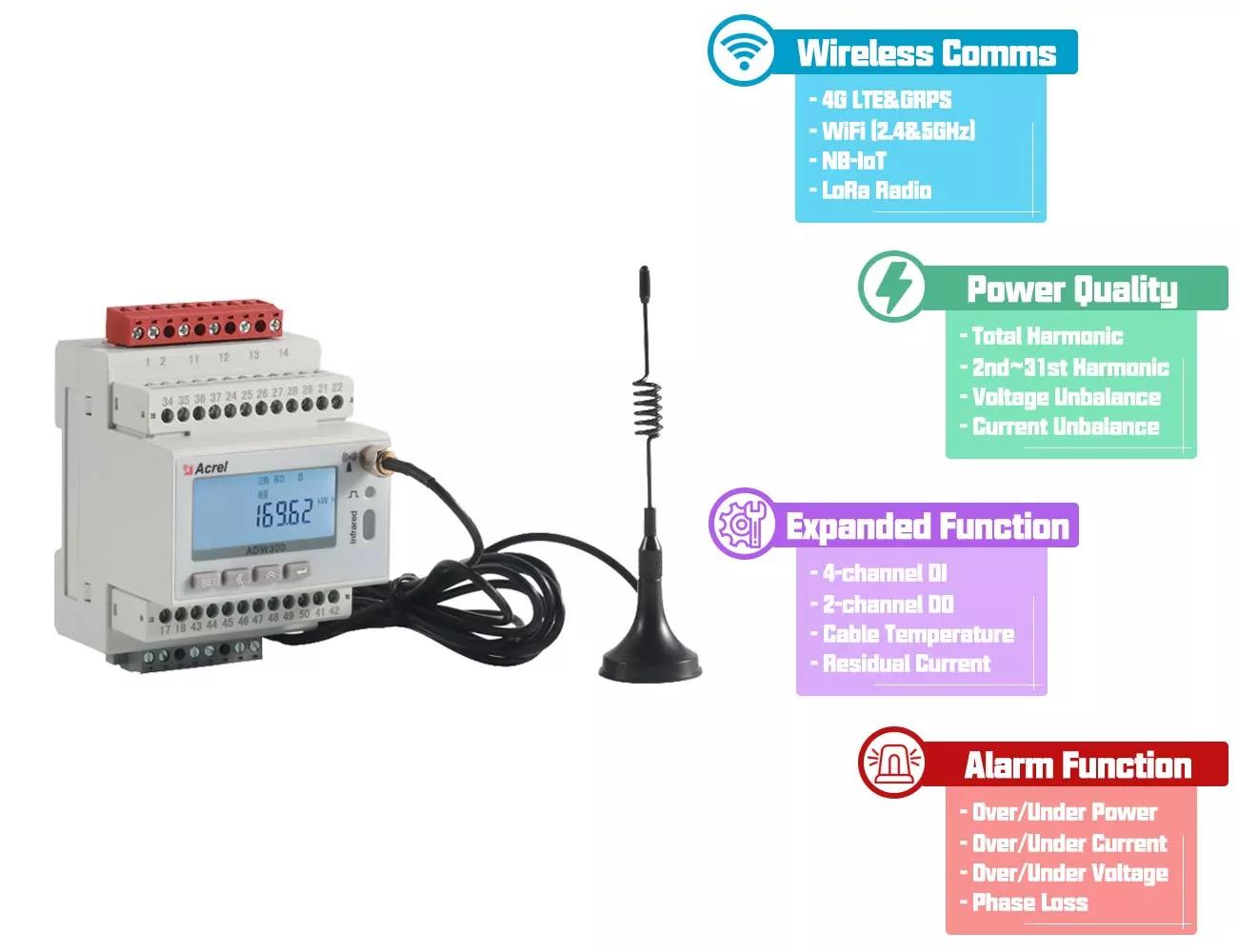

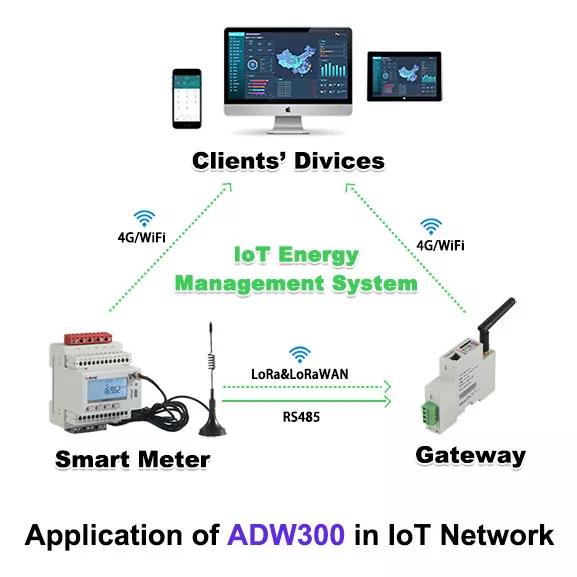
Multiple Communication Methods
● 4G LTE
● NB-IoT
● WiFi (2.4GHz&5GHz)
● LoRa
● RS485 (MODBUS-RTU)
● Paired with IoT Energy Monitoring System
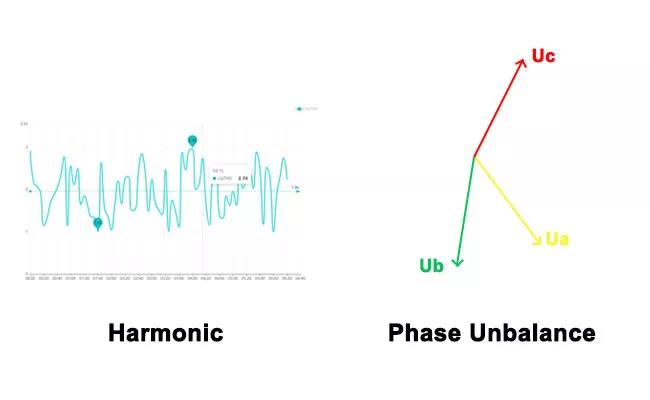
Power Quality Analysis
● Total Harmonic
● 2nd~31st Harmonic
● Voltage Unbalance
● Current Unbalance
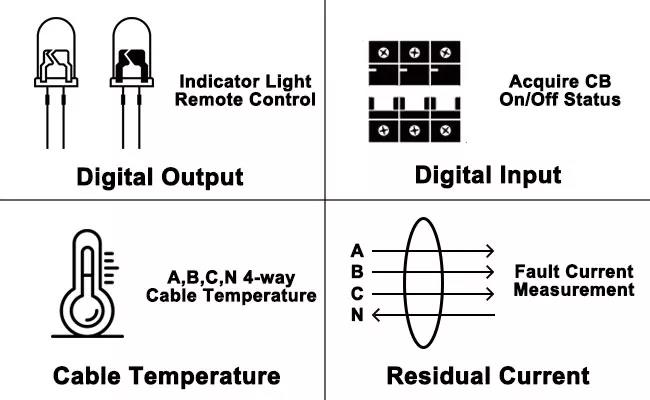
Expanded Function
● 2-channel DO (Digital Ouput)
● 4-channel DI (Digital Input)
● 4-channel Cable Temperature Monitoring
● 1-channel Residual Current Measurement

Alarm Function
● Over/Under Current
● Over/Under Voltage
● Over/Under Power
● Phase Loss

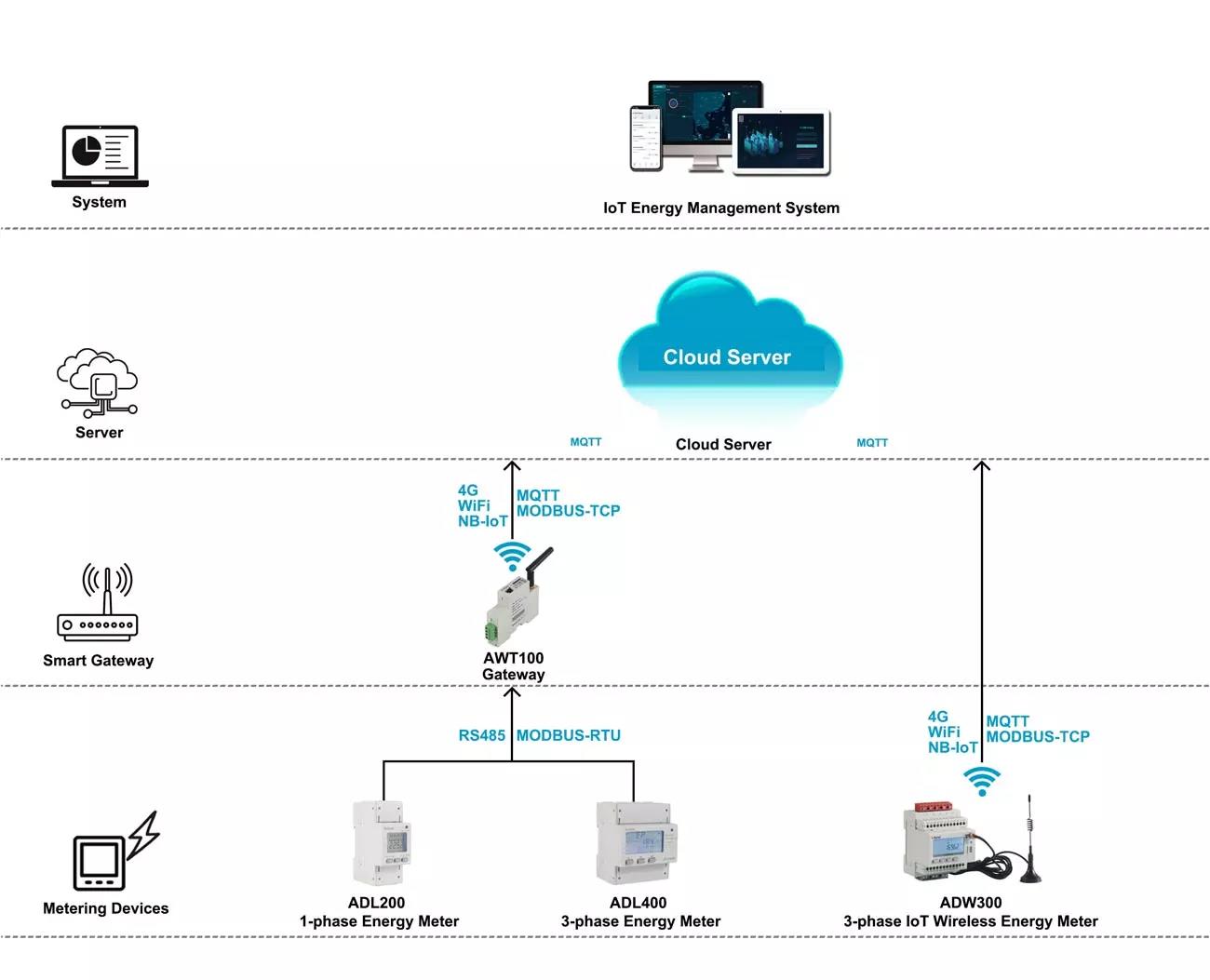
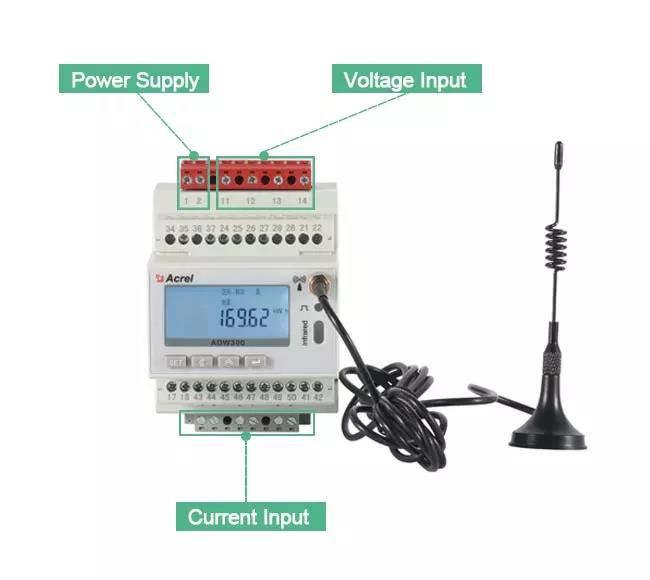
Step ①: Correctly install&wire meters
1. 35mm DIN-rail installation
2. 3-phase 4-wire or 3-phase 3-wire methods
3. Voltage signal input via direct connect or PTs
4. Current signal input via CTs or Rogowski Coils
5. Power supplied by 85~265Vac L-N power source
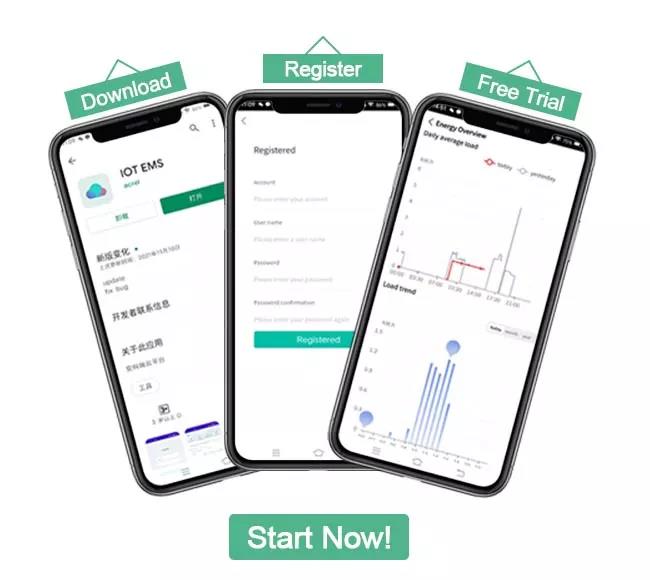
Step ②: Download&Register IoT APP
1. Introduction of IoT Energy Monitoring Solution (IoT EMS)
2. Introduction of IoT EMS APP (for mobile users)
3. Introduction of IoT EMS WEB (for PC users)
4. Download of IoT EMS APP
5. Register your account with 3-month Free Trial
6. Or contact us to get Test Account

Step ③: Add Meters to your Account
1. Meters are recognized by unique SN code
2. Scan QR code to add meter to your account
3. Edit CT&PT ratio according to paired CT&PT
4. If voltage input via direct connect, PT ratio set to 1 (Actual Power System Voltage = Voltage Signal Input of Meter)
5. If current input via 250A/5A CTs for example, CT ratio set to 50 (250÷5=50)
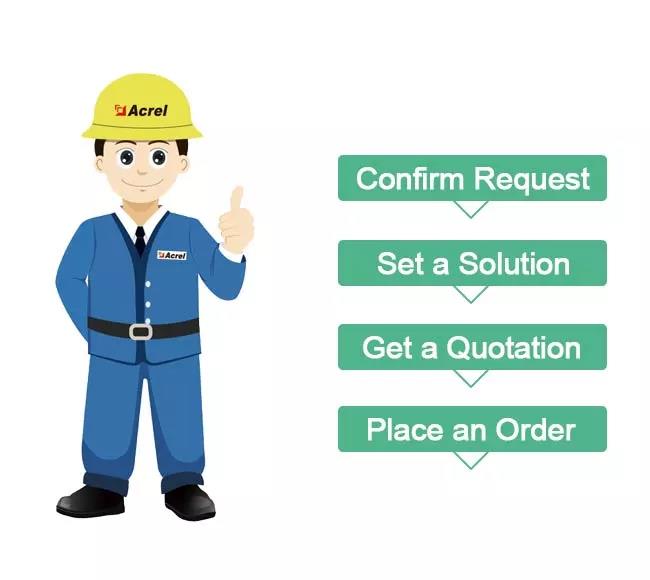
Step ④: Start your 3-month Free Trial
1. After 3 months, host service&buy-out service will be available for account renewal
2. Contact us for more information about system charge item&meter quotation
3. Before we send you the quotation, we will set a solution acoording to your request
4. Provide full technical support for installing meters and connecting meters to our system
Q:What's the biggest advantage of ADW300?
A:ADW300 has its built-in wireless communication module which allow it to realize 4G LTE, WiFi, NB-IoT, LoRa upstream communication without using extra IoT gateways. For the application scenarios when the meters can't be of centralized installation, ADW300 will usually be the best option for monitor 3-phase circuits that were far from each other.
Q:How should I deal with RS485 network communication malfunction?
A:First, check if the wiring of RS485 communication line was loosen or wired incorrectly.(like reversely wiring the A,B terminal).
Next,inspect if the meter’s setting of address, baud rate, check bit was correct by using keypads on the meter.
Q:What if LoRa communication of meters malfunctioned?
A:First, use USB to RS485 serial converter to connect the meter with computer. Then use adjustment software to check if setting of meter is on consensus with the setting of master station.(setting of channel and spreading factor--SF)
If setting remain the same, then it might be due to large interference of work site or the excessively far range between meter and host. In that case, it’s recommended to use chuck antenna or set a new master station nearby.
Q:What’s the difference between ADW300 and ADW300W
A:ADW300 has internal current transformers and can select compatible current transformer according to the site current to realized a secondary connection via CTs.
ADW300W on the other hand, has external current transformers.(non-detachable or it will damage the meter) This kind of design extremely ease the wiring and installation if the work-site already has CTs.
Q:What do 3×57.7/100V,3×220/380V,3×380/660V,3×100V,3×380V,3×660V represent respectively?
A:The meter’s spec of 3*100V,3*57.7/100V is suitable for high voltage power system while pairing with PT(potential transformer or voltage transformer). Beside, 3*100V represent 3-phase 3-wire and 3*57.7/100V represent 3-phase 4-wire.
The meter’s spec of 3*220/380V,3*380/660V,3*380V,3*660V is suitable for low voltage power system(directly connect with meter). Meanwhile,3*380V,3*660V represent 3-phase 3-wire and 3*220/380V,3*380/660V represent 3-phase 4-wire.
Other Question? Please contact us and we will get back to you as soon as possible.
Function Overview
|
Function |
Description |
|
Measurement |
Three-phase AC kWh, kVarh, Active Power, Reactive Power,
|
|
Measurement |
Temperature Measurement:4-channel (A,B,C,N) Cable Temperature Monitoring;
|
|
Residual Current Measurement: 1-channel Residual Current Monitoring |
|
|
Communication |
RS485 Port with Modbus-RTU protocol - 1 start bit,8 data bit,
|
|
Communication |
4G LTE - Normal Communicaiton Module Support: LTE-FDD: B1/B3/B5/B8;
|
|
WiFi - Support 2.4GHz or 5GHz |
|
|
LoRaWAN |
|
|
LoRa |
|
|
NB-IoT |
|
|
Display |
LCD Display and LED Indicator |
|
HMI |
Keypads Programming: Setting of CT/PT Ratio, Communication, Phase Wiring and etc |
|
Software |
Adjustment Software: Setting of Data Upload Interval, |
|
Alarm Function |
Undervoltage, Overvoltage, Undercurrent, Overcurrent,
|
|
I/O Function |
4-channel or 2-channel DI (Digital Input) |
Main Parameters
|
Parameter |
Description&Value |
|
|
Voltage |
Rated Voltage |
3x380~456Vac L-L or 3x660~792Vac L-L (via direct connection) |
|
Reference Frequency |
45~65Hz |
|
|
Power Consumption |
<0.5VA (each Phase) |
|
|
Current |
Rated Current |
3x1(6)A AC (via CTs) |
|
Starting Current |
1% Ib (Class 0.5); 4% Ib(Class 1) |
|
|
Power Consumption |
<1VA (each Phase) |
|
|
Phase |
3P4W |
3-phase 4-wire |
|
3P3W |
3-phase 3-wire |
|
|
Auxiliary |
Voltage Range |
85~265Vac |
|
Power Consumption |
<2W |
|
|
Measurement |
Standard |
IEC 62053-22:2003; IEC 62053-21:2003 |
|
kWh Accuracy |
Class 0.5S |
|
|
Pulse |
Width of Pulse |
80±20ms |
|
Pulse Constant |
6400imp/kWh; 400imp/kWh |
|
Environment
|
Condition |
Description&Value |
|
Temperature |
Operating Temperature: -20℃~+55℃; Storage Temperature: -40°C ~+70°C |
|
Humidity |
≤95%RH,no condensation,without corrosive gas |
|
Altitude |
≤ 2000m |


